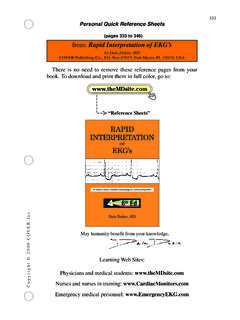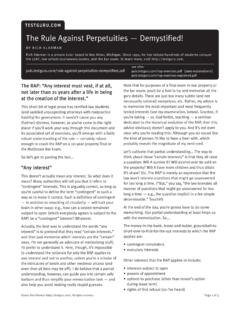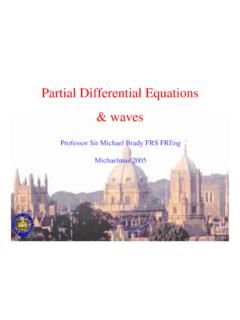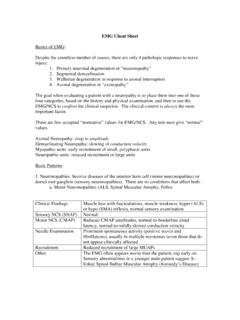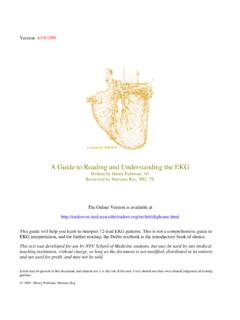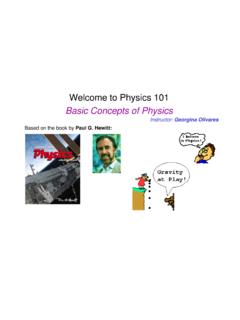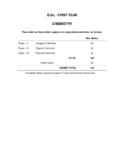Transcription of from: Rapid Interpretation of EKG’s
1 333 Copyright 2000 COVER Quick Reference Sheetsfrom: Rapid Interpretation of EKG sby Dale Dubin, MDCOVER Publishing Co., Box 07037, Fort Myers, FL 33919, USAT here is no need to remove these reference pages from yourbook. To download and print them in full color, go to:May humanity benefit from your knowledge, (pages 333 to 346)6th sDale Dubin, MDDr. Dubin s classic, simplified methodology for understanding EKG sLearning Web Sites:Physicians and medical students: and nurses in training: medical personnel: Reference Sheets 334 Copyright 2000 COVER : Rapid Interpretation of EKG sby Dale Dubin, MDCOVER Publishing Co., Box 07037, Fort Myers, FL 33919, USAP ersonal Quick Reference SheetsDubin s MethodforReading EKG s1. RATE (pages 65-96)Say 300, 150, 100.
2 75, 60, 50 but for bradycardia:rate = cycles/6 sec. strip 102. RHYTHM (pages 97-202)Identify the basic rhythm, then scan tracing for prematurity,pauses, irregularity, and abnormal waves. Check for: P before each after each P. Check: PR intervals (for AV Blocks).QRS interval (for BBB). If Axis Deviation, rule out AXIS (pages 203-242) QRS above or below baseline for Axis Quadrant(for Normal vs. R. or L. Axis Deviation).For Axis in degrees, find isoelectric QRS in a limb leadof Axis Quadrant using the Axis in Degrees chart. Axis rotation in the horizontal plane: (chest leads)find transitional (isoelectric) HYPERTROPHY (pages 243-258)P wave for atrial wave for Right Ventricular wave depth in + R wave height in V5 for Left Ventricular INFARCTION (pages 259-308)Scan all leads for: Q waves Inverted T waves ST segment elevation or depressionFind the location of the pathology (in the Left ventricle),and then identify the occluded coronary {335 Copyright 2000 COVER Quick Reference Sheetsfrom: Rapid Interpretation of EKG sby Dale Dubin, MDCOVER Publishing Co.}
3 , Box 07037, Fort Myers, FL 33919, USARate (pages 65 to 96)Determine Rate by Observation (pages 78-88)Bradycardia (slow rates) (pages 90-96) Cycles/6 second strip 10 = Rate When there are 10 large squares between similar waves, the rate is 30 Rhythm: origin is the SA Node ( Sinus Node ), normal sinus rate is 60 to 100/minute. Rate more than 100/min. = Sinus Tachycardia (page 68). Rate less than 60/min. = Sinus Bradycardia (page 67).Determine any co-existing, independent (atrial/ventricular) rates: Dissociated Rhythms: (pages 155, 157, 186-189) A Sinus Rhythm (or atrial rhythms) may co-exist with an independent rhythm from an automaticity focus of a lower level. Determine rate of Rhythms: (pages 107-111) With Irregular Rhythms (such as Atrial Fibrillation) always note the general (average) ventricular rate (QRS s per 6-sec.)
4 Strip 10) or take the patient s division/rate association: reference (page 89)May be calculated: 1500 = RATE mm. between similar waves30015010075602502141871671361251151 079488837971686562 START 300 150 100 75 60 50 Using the triplets:Name the lines following the Start 2000 COVER : Rapid Interpretation of EKG sby Dale Dubin, MDCOVER Publishing Co., Box 07037, Fort Myers, FL 33919, USAP ersonal Quick Reference Sheets Identify basic scan entire tracing for pauses, premature beats,irregularity, and abnormal waves. Always: Check for: P before each after each P. Check: PR intervals (for AV Blocks).QRS interval (for BBB). Has QRS vector shifted outside normal range? (to rule out Hemiblock).
5 Irregular Rhythms (pages 107-111)Sinus Arrhythmia (page 100)Irregular rhythm that varieswith P waves are Pacemaker (page 108)Irregular rhythm. P waveschange shape aspacemaker location under 100 if the rate exceeds100/minute, then it is calledMultifocal Atrial Tachycardia(page 109)Atrial Fibrillation (pages 110, 164-166)Irregular ventricular atrial spikes(no P waves) frommultiple atrial automaticityfoci. Atrial dischargesmay be difficult to (pages 97 to 111)337 Copyright 2000 COVER Quick Reference Sheetsfrom: Rapid Interpretation of EKG sby Dale Dubin, MDCOVER Publishing Co., Box 07037, Fort Myers, FL 33919, USAR hythm continued (pages 112 to 145)Escape (pages 112-121) the heart s response to a pause in pacing An unhealty Sinus (SA) Node mayfail to emit a pacing stimulus( Sinus Block ); this pause mayevoke an escape beat from anautomaticity focus.
6 But a sick Sinus (SA) Node maycease pacing ( Sinus Arrest ),causing an automaticity focus to escape to assume pacemakerstatus. An irritable automaticityfocus may suddenlydischarge, producing a:Premature Beats (pages 122-145) from an irritable automaticity focusPremature Atrial Beat(pages 124-130)Premature Ventricular Contraction(pages 135-141)PVC s may be:multiple, multifocal, in runs, orcoupled with normal Junctional Beat(pages 131-133)pauseAtrialEscape BeatororVentricularEscape SA Nodeusally Beat(page 119)(page 120)(page 121)++++++++++++++++++++++++++++++++++++ ++++++++++++++++++(page 114)(pages 115-116)(page 117)( idiojunctional rhythm )( idioventricular rhythm )AtrialEscape RhythmRate 60-80 RhythmRate 40-60 RhythmRate 20-40 2000 COVER : Rapid Interpretation of EKG sby Dale Dubin, MDCOVER Publishing Co.
7 , Box 07037, Fort Myers, FL 33919, USAP ersonal Quick Reference SheetsAtrial FlutterA continuous ( saw tooth ) Rapid sequenceof atrial complexes from a single Rapid -firingatrial focus. Many flutter waves needed toproduce a ventricular response. (pages 159, 160)Ventricular Flutter (pages 161, 162) also see Torsades de Pointes (pages 158, 345)A Rapid series of smooth sine waves from asingle Rapid -firing ventricular focus; usually ina short burst leading to Ventricular Atrial TachycardiaAn irritable atrial focus discharging at150-250/min. produces a normal wavesequence, if P' waves are visible. (page 149) with blockSame as but only everysecond (or more) P' waveproduces a QRS. (page 150)Paroxysmal Junctional TachycardiaAV Junctional focus produces a rapidsequence of QRS-T cycles at 150-250 may be slightly widened.
8 (pages 151-153)Paroxysmal Ventricular TachycardiaVentricular focus produces a Rapid (150-250/min.) sequence of (PVC-like)wide ventricular complexes. (pages 154-158)Rhythm continued (pages 146 to 172)multiple foci dischargingRates:ParoxysmalTachycardiaFl utterFibrillation150250350450 Tachyarrhythmias (pages 146-172), focus = automaticity focus Supraventricular Tachycardia (page 153)Fibrillation ..erratic (multifocal) Rapid discharges at 350 to 450/min. (pages 167-170)Atrial Fibrillation (pages 110, 164-166)Multiple atrial foci rapidly dischargingproduce a jagged baseline of tiny (QRS) response is Fibrillation (pages 167-170)Multiple ventricular foci rapidly dischargingproduce a totally erratic ventricular rhythmwithout identifiable waves. Needs (sudden) Tachycardia ..rate: 150-250/min.
9 (pages 146-163)fusionFlutter ..rate: 250-350 2000 COVER Quick Reference Sheetsfrom: Rapid Interpretation of EKG sby Dale Dubin, MDCOVER Publishing Co., Box 07037, Fort Myers, FL 33919, USA1 AV Block ..prolonged PR interval (pages 176-178).PR interval is prolonged to greaterthan .2 sec (one large square).2 AV Block .. some P waves without QRS response (pages 179-185)Wenckebach ..PR gradually lengthens with each(pages 180-182,cycle until the last P wave in the183)series does not produce a ..some P waves don t produce a QRS(pages 181-183)response. If intermittent, anoccasional QRS is advanced Mobitz block mayproduce a 3:1 (AV) pattern or evenhigher AV ratio (page 181).2:1 AV Block ..may be Mobitz or Wenckebach.(pages 182, 183)PR length and QRS width orvagal maneuvers help ( complete ) AV Block.
10 No P wave produces a QRS response (pages 186-190)3 Block:P waves SA Node origin.(page 188)QRS s if narrow, and if theventricular rate is 40 to 60 per min.,then origin is a Junctional Block:P waves SA Node origin.(page 189)QRS s if PVC-like, and if theventricular rate is 20 to 40 per min.,then origin is a Ventricular (SA) Block (page 174)An unhealthy Sinus (SA) Node misses one or more cycles (sinus pause)..the Sinus Node usually resumes pacing, butthe pause may evoke an escape responsefrom an automaticity focus. (pages 119-121) Always Check: has Axis shiftedoutside Normalrange? Always Check: is QRS within3 tiny squares? Always Check: PR intervals less than one large square? Is every P wave followed by a QRS?Rhythm: ( heart ) blocks (pages 173 to 202)Caution:With Left BBBinfarction is difficultto determine on BBB (pages 194-196)Left BBB (pages 194-197)RQRS in V1 or V2R'RQRS in V5 or V6R'With Bundle BranchBlock the criteria forventricular hypertrophyare Block (pages 176-189)Blocks that delay or prevent atrial impulses from reaching the Branch Block.
